Potřebujeme váš souhlas k využití jednotlivých dat, aby se vám mimo jiné mohly ukazovat informace týkající se vašich zájmů. Souhlas udělíte kliknutím na tlačítko „OK“.
ASTM F2065-00(2010)
Standard Practice for Testing for Alternative Pathway Complement Activation in Serum by Solid Materials (Withdrawn 2016)
Automaticky přeložený název:
Standardní postup zkoušení pro alternativní cesta aktivace komplementu v séru by pevných látek
NORMA vydána dne 1.9.2010
Informace o normě:
Označení normy: ASTM F2065-00(2010)
Poznámka: NEPLATNÁ
Datum vydání normy: 1.9.2010
Kód zboží: NS-52652
Počet stran: 7
Přibližná hmotnost: 21 g (0.05 liber)
Země: Americká technická norma
Kategorie: Technické normy ASTM
Kategorie - podobné normy:
Anotace textu normy ASTM F2065-00(2010) :
Keywords:
alternative pathway, biocompatibility, blood compatibility, complement testing, materials, medical devices, Alternative pathway complement activation, Barbitol (veronal) buffer, Biocompatibility, Blood compatibility, Blood materials/applications, C-4 deficient Guidea Pig serum (C4-GPS), Complement activation, Fabrication (of medical devices), Medical devices/equipment, Rabbit RBC (red blood cells), Red blood cells (RBC), Screen analysis--medical/surgical applications, Serum
Doplňující informace
| Significance and Use | ||||||
|
Inappropriate activation of complement by blood-contacting medical devices may have serious acute or chronic effects on the host. Solid medical device materials may activate the complement directly by the alternative pathway. Unlike the classical complement activation pathway (see Practice F1984), antibodies are not required for alternative pathway activation. This practice is useful as a simple, inexpensive screening method for determining alternative whole complement activation by solid materials in vitro. This practice is composed of two parts. In Part A (Section 10) C4(-)GPS is exposed to a solid material. Since C4 is required for classical pathway activation, activation of complement in C4(-)GPS can only occur by the alternative pathway (1). In principle, nonspecific binding of certain complement components to the materials may also occur. In Part B (Section 11), complement activity remaining in the serum after exposure to the test material is assayed by alternative pathway-mediated lysis of rabbit RBC. Assessment of in vitro whole complement activation as described here provides one method for predicting potential complement activation by solid medical device materials intended for clinical application in humans when the material contacts the blood. Other test methods for complement activation are available, including assays for specific complement components and their split products in human serum (X1.3 and X1.4). This in vitro test method is suitable for adoption in specifications and standards for screening solid materials for use in the construction of medical devices intended to be implanted in the human body or placed in contact with human blood outside the body. |
||||||
| 1. Scope | ||||||
|
1.1 This practice provides a protocol for rapid, in vitro screening for alternative pathway complement activating properties of solid materials used in the fabrication of medical devices that will contact blood. 1.2 This practice is intended to evaluate the acute in vitro alternative pathway complement activating properties of solid materials intended for use in contact with blood. For this practice, “serum” is synonymous with “complement.” 1.3 This practice consists of two procedural parts. Procedure A describes exposure of solid materials to a standard lot of C4-deficient guinea pig serum [C4(-)GPS], using 0.1-mL serum per 13 × 100-mm disposable glass test tubes. Sepharose CL-4B is used as an example of test materials. Procedure B describes assaying the exposed serum for significant functional alternative pathway complement depletion as compared to control samples. The endpoint in procedure B is lysis of rabbit RBC in buffer containing EGTA and excess Mg++. 1.4 This practice does not address function, elaboration, or depletion of individual complement components except as optional additional confirmatory information that can be acquired using human serum as the complement source. This practice does not address the use of plasma as a source of complement. 1.5 This practice is one of several developed for the assessment of the biocompatibility of materials. Practice F748 may provide guidance for the selection of appropriate methods for testing materials for other aspects of biocompatibility. Practice F1984 provides guidance for testing solid materials for whole complement activation in human serum, but does not discriminate between the classical or alternative pathway of activation. 1.6 The values stated in SI units are to be regarded as standard. No other units of measurement are included in this standard. |
||||||
| 2. Referenced Documents | ||||||
|
Podobné normy:
Historická
1.5.2013
Historická
1.10.2013
Historická
1.9.2013
Historická
1.3.2013
Historická
1.10.2013
Historická
1.12.2013
Odebírejte informace o nově vydaných normách ZDARMA:
Chcete pravidelně odebírat informace o nově vycházejících normách z celého světa a to zcela zdarma?
Přihlašte se k odběru. Vše je velice jednoduché a absolutně ZDARMA.
Na výběr máte vydavatele z celého světa.


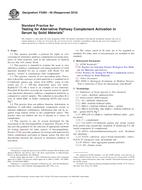
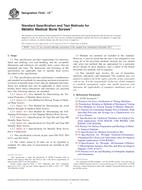 ASTM F543-13e1
ASTM F543-13e1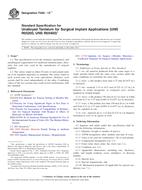 ASTM F560-13e1
ASTM F560-13e1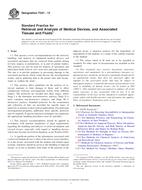 ASTM F561-13
ASTM F561-13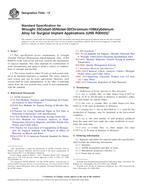 ASTM F562-13
ASTM F562-13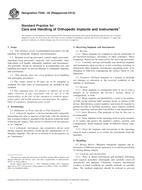 ASTM F565-04(2013)..
ASTM F565-04(2013)..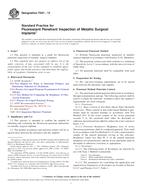 ASTM F601-13
ASTM F601-13
 Cookies
Cookies
